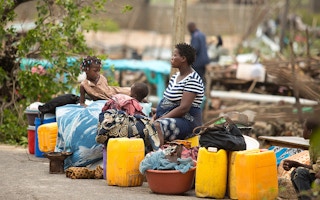The destruction left in the wake of Cyclone Idai has been nothing short of devastating. Millions of lives have been torn apart. Entire villages have been submerged. Families have lost everything. But there is one consequence of the crisis that receives far less attention: the effect that it will have on girls.
When natural disasters strike, it is often girls who are hit the hardest. From last year’s earthquake on the Indonesian island of Lombok, to floods in Bangladesh and the 2015 Nepal earthquake, there is growing evidence that natural disasters are linked to increasing child marriage rates. Each year, 12 million girls are married before the age of 18, many of them in countries particularly vulnerable to natural disasters.
Malawi and Mozambique already had critically-high rates of child marriage before the cyclone hit: In Mozambique alone almost half of all girls are married before the age of 18. The crisis caused by Cyclone Idai could heighten the risks faced by girls, exacerbating poverty, hunger, insecurity and a lack of access to education—all factors that drive parents to marry of their daughters in the first place.
Devastating consequences
Natural disasters such as the El Niño droughts of 2015-2017 have already had a heavy and lasting impact on the lives of girls in Mozambique. A report by the NGO CARE International found that droughts tended to increase child marriage in the country as families who lost their livelihoods, land and homes were pushed to marry off their daughters as a source of income, or to reduce the number of mouths to feed.
The risk that girls will suffer the same fate in the aftermath of Cyclone Idai is particularly acute. Many families have lost everything—their homes, their livelihoods and family members. Some children have lost their parents, while others have been separated from their families. Parents increasingly turn to child marriage as a coping strategy in insecure environments, such as displaced communities. It is often seen as a way to protect their girls from sexual violence, and provide for their future.
“
A report by CARE International found that droughts tended to increase child marriage in the country.
The impacts of this crisis on girls will be far reaching. Long after the flood waters have receded and the destruction caused by Cyclone Idai is forgotten by the rest of the world, married girls could remain trapped in a cycle of poverty and violence. Child marriage is not just about one wedding day; it denies girls their rights and their childhood, and deprives them of any chance of a bright future after a crisis.
Make girls’ needs a priority
In their ongoing efforts to rebuild the communities torn apart by the cyclone, it is crucial that international and national aid organisations pay special attention to the risks faced by girls.
The risk of child marriage must be factored into aid efforts across all humanitarian sectors, from healthcare and education to nutrition and sanitation. This means focusing on safe access to quality education for girls, both during and after a crisis.
It means providing food security and livelihood initiatives to ensure that families’ basic needs are met, and they have the resources to care for their daughters without turning to child marriage. It means addressing the risks of violence that girls face at water points and latrines, and on their way to health services. Importantly, it means involving girls and women from the early stages of a crisis and including their needs in planning.
These responses must be driven by women and girls who have been affected by child marriage and sexual violence. They are best placed to understand their own contexts, and can help find ways to keep themselves and their peers safe.
Finally, there is still a lot we need to learn about the links between natural disasters and child marriage. We need much more research on how girls are affected by crises and what must be done to ensure rates of child marriage don’t increase. This will help us target our responses more effectively.
The floods have already taken so much. At the very least, we cannot let them deny girls their rights to a healthy, happy future.
Julie Rialet-Cislaghi is Research and Policy Officer at Girls Not Brides: The Global Partnership to End Child Marriage. This story was published with permission from Thomson Reuters Foundation, the charitable arm of Thomson Reuters, that covers humanitarian news, climate change, resilience, women’s rights, trafficking and property rights. Visit http://news.trust.org/climate.


















